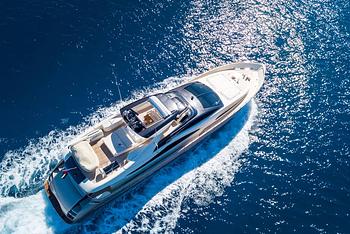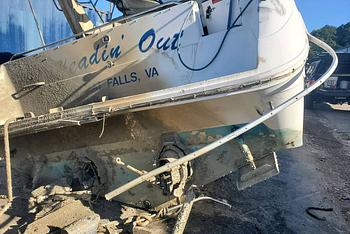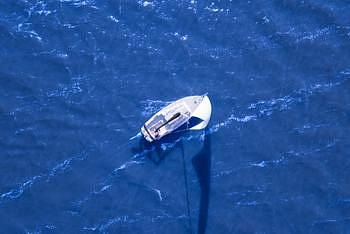Boat inspections before purchase are vital to be sure you’re buying a sound boat and spending your money wisely. Use this checklist as your guide as we walk you through every step of the process. If you’re still early in the boat-buying process, we recommend you read our in-depth article How to Buy a Boat: The Ultimate Guide as well as learning what others got wrong by checking out the 9 Mistakes to Avoid when Buying a Boat.
There are differences when it comes to buying new and used boats; conducting inspections and knowing what to look for when buying a used boat are vital. Fresh out of the factory, boats won’t require this and will come with warranties to ensure everything is as it should be. When it comes to used boats, however (whether you’re buying a used boat from a private party or a broker), inspections are vital to make sure you’re buying a sound boat and spending your money wisely. There are many steps to buying a used boat, and viewing a boat you’re interested in is the very first one. It will give you that all-important first impression of the condition of the boat, at which point you decide to forge ahead or walk away. We highly recommend getting a complete marine survey done on any boat you’re considering buying, as experienced surveyors will know the problems to look for and where to find them.
But before you get to the stage of paying for a marine survey, have a read through our 7 Hidden Problems to Check for When Buying a Used Boat and use this checklist as a guide to make a thorough boat inspection before purchase.

Conducting inspections and knowing what to look for when buying a used boat are vital.
Pre-Inspection Checklist
- Ask to see servicing and maintenance records. Knowing a boat has had regular servicing and maintenance is a very good start and learning about past repairs may give you the chance to ask worthwhile questions. Ideally, the boat will have been serviced annually.
- Find out how the boat has been used. You can learn a lot with this question to give you insight into how well it has been maintained, where it has been used (saltwater versus freshwater), where it was stored, any damage that might have occurred, etc. Use it as a conversation starter and ask follow-up questions.
- Where has the boat been stored? In general, boats stored outside in the water are likely to have suffered more wear and tear than those stored in dry, covered conditions. The effects of close proximity to salt water, freezing water, and inclement weather can cause corrosion and damp. That doesn’t mean you shouldn’t ever buy a boat stored in the water—indeed one could argue that it may have been kept there because it was used more and therefore better maintained.
- Ask about any damage. While minor damage that has been repaired or is not visible might not be declared, it is still worth asking as it may raise previous issues you can mention later to a marine surveyor.
- How many hours does the engine have logged? Ask how many hours the engine has on it and when it was last serviced, as well its regular service program.
- Know what is included in the price. Make sure you ask the seller or broker to list exactly what is included at the asking price. This may include safety gear, electronics, or fishing equipment, for example. You’ll then want to ensure that the equipment is in good working order; otherwise you might be paying extra for what you could buy cheaper yourself.
- Is the boat still under warranty and is it transferable? Depending on the age of the boat, it might still be within its warranty, which is a valuable document to have in your possession. Ask whether the boat still has a warranty, how much time is left on the warranty, what the warranty covers, and whether the warranty is transferable to you.
Visual Boat Inspection Checklist
Exterior
Start with a visual inspection of the exterior of the boat and get a feel not only for its condition but also its space and layout. Remember you want a sound boat, but you also want to choose the right boat for you, your family, and your specific needs.
- Check for damage or repairs. While cleanliness isn’t necessarily a sign of poor condition, it can raise flags as to how well the boat has been cared for. Check for cracks in the fiberglass, signs of repairs to the bodywork, scratches, or discolored areas where damage may have been repaired. If the boat is out of the water (which it should be at some point when viewed it), check for bubbles in the fiberglass indicating osmosis (these are difficult and costly to fix), and that there are no gouges or scraping on the bottom of the hull or keel that might become problematic down the line.
- Inspect the transom, decks, bilge, and fuel tank. The transom is where an outboard engine would usually be mounted. You want to be looking for any signs of waterlogged wood which could signal a major problem. While this is a less common problem in modern boats, older wooden boats are particularly susceptible to rot. Likewise, check the decks for signs of warping, rotting or softness from water intrusion. You’ll also want to check the bilge area for any signs of oil leaking from the engine, and the fuel tank for signs of corrosion.
- Ensure the stringers are well-connected. Stringers should be well connected to the hull, otherwise, the vessel is structurally at risk. While it isn’t always easy to see them, and you may need to venture into the bilge with a good light, it is a must. Any separation or damage should be treated with extreme wariness. If you’re not keen on getting down into the bilge, then mark this as something you want your surveyor to do.
- Rigging. On a sailing yacht, you’ll want to check the rigging and sails as these are expensive items to replace. On a regular cruising yacht, these typically should be replaced every 10 years, so ask when the current sails were purchased and if you can spread them out, you can inspect for damage or wear; the softer or more wrinkles you find in the Dacron material, the shorter the sail’s remaining lifespan.

If the boat is out of the water, check for bubbles in the fiberglass indicating osmosis, and that there are no gouges or scraping on the bottom of the hull or keel that might become problematic down the line,
Engine and Electrics
The engine is the most important part of any power boat, and you’ll want a professional to give it a thorough going-over before committing to a purchase.
- Check the oil. Ensure the oil doesn’t have a milky residue as this could signal water ingress. You can do this by pulling out the dipstick.
- Look for rust. Rust around the engine might indicate that the boat has been submerged in water for a long period of time, and its presence should set alarm bells ringing.
- Inspect the hoses, belts, and electrical connections. Have a close look at the hoses, belts, and electrical connections such as spark plugs to make sure they’re not cracked or worn.
- Check the propeller. Cracks in a propeller can be fixed, so aren’t always a red flag, but if you notice cracks or repairs, be sure to ask about them.
- Listen. Listen to the sound of the engine as it’s turned on and while running. You can do this during a sea trial, which is highly recommended, but also at the dock. Listen for excessive noise or vibrations, or unusual or rough sounds. Remember, boats don’t have odometers like cars, so it’s not easy to know how many hours a boat engine has run.
- Inspect the electrics. Rewiring is an expensive job on a boat, so spend time looking at as much of the electrical systems as you can. Start by switching on and off every single electrical item on board, before looking at the fuse box. A mixture of fuses might imply replacement, which in a newer vessel should raise some questions. Look at the wiring itself and get an idea of the condition.
Interior
The interior of a boat can give you a good idea of the care a boat has received and also highlight issues with the hull itself.
- Mold and mildew. Your first sign of interior mold and mildew is a strong, musty smell. Do a visual inspection too, looking for signs of rot on the floors or seating areas. Any warping is also a red flag.
- Leaks. Leaks in the hull may have been repaired and well hidden, so they may not be instantly visible. A good idea is to spray a hose at the hull, hatches, port holes, and seams and see if any moisture makes its way into the interior cabins.
- Check the doors, hatches, and windshield. As part of your visual boat inspection of the interior, be sure to open and close doors, portholes, and hatches to make sure they are watertight. The windshield should be secure with no cracks.
- Get a feel for the boat. As with the exterior, get familiar with the layout, style, and the décor. You may want to put your own stamp on the boat and design your own dazzling boat interior, but if not then consider the cost, if the soft furnishings are not up to par.
Get a Pre-Purchase Survey and Sea Trial
An inspection is highly recommended and will give you a better understanding of the condition of the boat before spending money on a pre-purchase survey (see our article Do I Need a Boat Survey When Buying a Used Boat? for more information). When it comes to pre-purchase surveys and sea trials, we almost always recommend having them conducted (unless the boat is very small or very inexpensive). An experienced marine surveyor will be able to do a thorough and in-depth report on the condition of the boat before you sign on the dotted line and provide you with the information to make a truly informed decision. You might want to run for the hills, or it might reassure you. You can always use the survey to negotiate the best price for a boat.
Rightboat.com lists thousands of used boats all over the world and is the best place to search for the perfect boat for you. We are here to help you every step of the way and have a huge resource centre filled with useful articles on buying a used or new boat. Please don’t hesitate to get in touch with our sellers, brokers, or the Rightboat.com team for more guidance.
This article was published in March 2021 and updated in December 2023.




